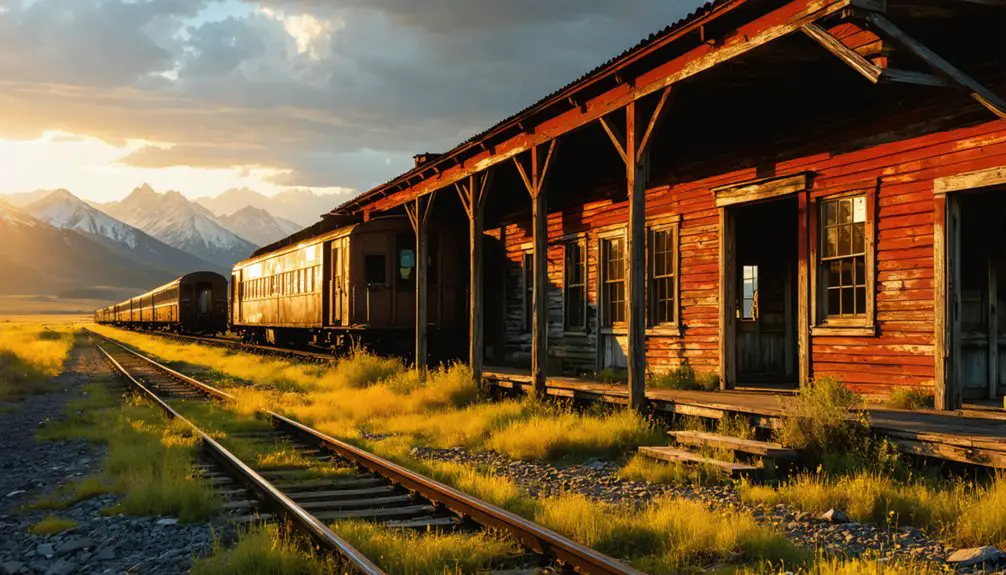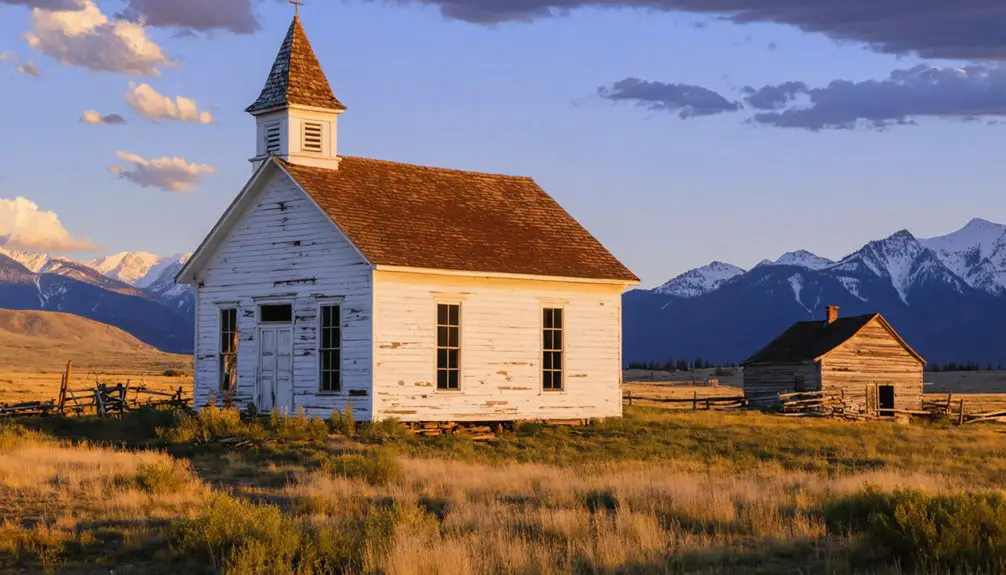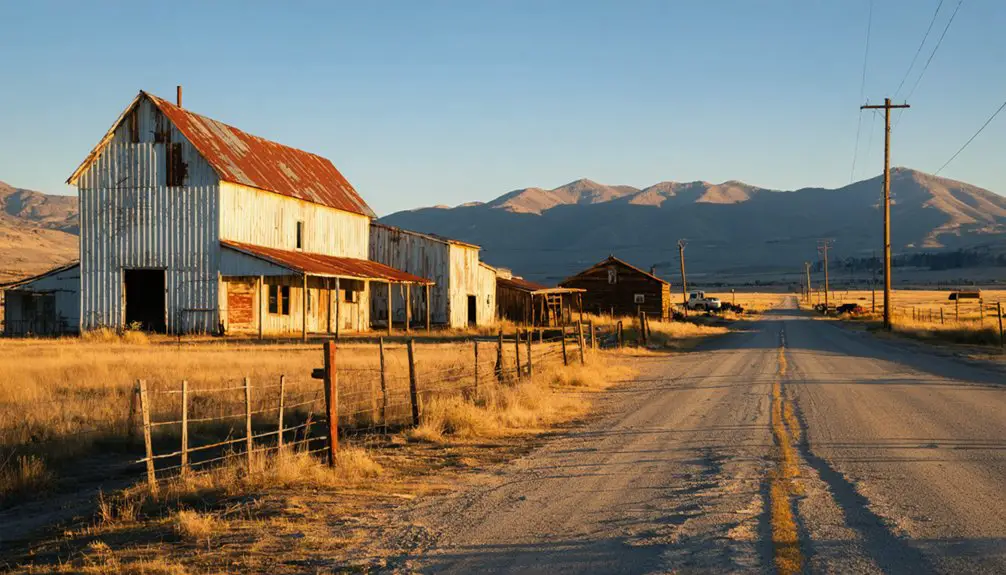You’ll find Maudlow nestled along Sixteen Mile Creek at 4,409 feet in Montana’s northern Rockies, named after railway pioneer Richard Harlow and his wife Maud. This once-bustling Milwaukee Road stop thrived as an essential mountain railway community, complete with a historic post office established in 1898. Today, the ghost town‘s weathered wooden buildings and abandoned railroad infrastructure stand as silent witnesses to Montana’s rich railroad heritage, with countless stories waiting in its quiet valley.
Key Takeaways
- Maudlow became a ghost town following the decline of railroad activity and significant job losses in Montana’s railroad industry.
- Named after railway pioneer Richard Harlow and his wife Maud, the town was established as a crucial railroad stop along Sixteen Mile Creek.
- The site features abandoned railroad infrastructure, deteriorating buildings, and historical remnants from the Milwaukee Road era.
- Located at 4,409 feet elevation in Montana’s northern Rockies, the ghost town sits in a sheltered valley with access to water sources.
- Preservation efforts focus on documenting the town’s railroad heritage through museums, archives, and adaptive reuse of remaining structures.
A Railway Town’s Birth: The Story Behind the Name
While many Montana railway towns were named after industry magnates or geographical features, Maudlow’s origin story carries a more personal touch.
You’ll find that Maudlow’s history stems from Richard A. Harlow, a railway pioneer who combined his wife Maud’s first name with his own surname to create the town’s unique identity.
As you explore the founder’s legacy, you’ll discover that Harlow wasn’t just naming another stop along his Montana Railway – he was weaving his family’s story into the fabric of the community.
This personal naming choice aligned with common practices of the era, when new railway towns often adopted their founders’ names.
The distinctive blend of first and last names made Maudlow stand out among Montana’s railroad communities, cementing its connection to the visionary who brought the rails through this territory.
The town remained an active Milwaukee Railroad stop until its eventual decline in the early 1980s.
Visitors interested in learning more about Maudlow’s history can contact the Montana History Portal at their Helena office location for additional historical documentation.
Peaks and Valleys: Maudlow’s Strategic Mountain Location
Nestled along Sixteen Mile Creek at an elevation of 4,409 feet, Maudlow’s strategic mountain location shaped its destiny as an essential railway waypoint.
You’ll find the town tucked into a sheltered valley of Montana’s northern Rockies, where the surrounding peaks provided natural protection from harsh winds and created manageable grades for rail lines.
The valley advantages were clear – Sixteen Mile Creek offered reliable water for steam engines, while the protected location supported pockets of vegetation and grazing land. The area served as a vital hub for ranchers and homesteaders who built their lives around the railway station.
Located at 46 degrees north, Maudlow’s position enabled favorable summer growing conditions for local agriculture.
Despite these benefits, mountain isolation proved challenging. You’d need to traverse 30 miles of rural backroads to reach the town, and winter snows often complicated travel.
Remote mountain living came at a price – miles of lonely roads and brutal winters kept Maudlow cut off from civilization.
This geographic positioning ultimately influenced both Maudlow’s rise as a railroad stop and its eventual decline into a ghost town.
Life Along the Milwaukee Road
As a railroad worker in Maudlow, you’d find your daily routine centered around maintaining the Milwaukee Road‘s crucial mountain passage through challenging terrain.
You’d join fellow crew members at the station house for shift changes and equipment checks, while the town’s businesses – from boarding houses to general stores – kept you supplied with essentials.
The community rallied around its railroad workforce, providing services like laundry, meals, and social gathering spaces that made life sustainable in this remote mountain outpost. The electric powered locomotives proved especially reliable during Montana’s harsh winter conditions. Regular electric operations began in October 1913, bringing significant cost savings to the railroad’s mountain operations.
Railroad Worker Daily Life
Throughout the steam era, railroad workers along the Milwaukee Road performed diverse and demanding roles that kept the transportation network running smoothly. You’d find engineers, conductors, and maintenance crews working long, irregular hours while handling heavy railroad machinery in conditions filled with soot and smoke.
Worker camaraderie developed through shared experiences of physical labor and operational challenges. Daily life involved constant movement along the tracks, whether you were inspecting rails, coordinating with dispatchers, or ensuring passenger comfort. Workers saw themselves represented in historical photographs that would later inspire commemorative artwork celebrating their contributions. The safety department actively trained crews on injury prevention practices to protect workers in these demanding conditions.
You’d learn specialized skills through apprenticeships and on-the-job training, adapting to everything from mechanical repairs to customer service. The work was tough but stable, anchoring local economies while fostering a distinct social identity among railroad employees who took pride in their essential role connecting communities across Montana.
Community Support Infrastructure
When the Milwaukee Road established its electrified route through Montana in 1914, it created an extensive support network that transformed remote mountain regions into functioning communities.
You’d find towns like Maudlow emerging around railroad operations, equipped with essential infrastructure to handle the harsh mountain environment. Despite infrastructure challenges, these communities developed remarkable resilience through interconnected support systems. The railroad’s massive construction costs required significant investment, as it had to purchase land from private owners rather than receiving government land grants. John D. Ryan of Anaconda Copper Mining played a key role in promoting the electrification efforts.
You could count on finding schools, grocery stores, and basic medical facilities adapted to serve railroad workers and their families.
The railroad’s electrification system, powered by local hydroelectric sources and utilizing Montana’s copper, brought modern amenities to these isolated areas. Communication lines along the tracks kept communities connected, while substations like Loweth #2 provided crucial power conversion services every 35 miles, enabling reliable train operations in temperatures as low as −40°F.
Architectural Legacy and Notable Structures
The architectural legacy of Maudlow stems directly from its railroad town origins, where the Montana Railway’s presence shaped both the urban layout and building styles.
You’ll find architectural styles that reflect the utilitarian needs of the era, with wood-frame construction dominating the landscape. Named after Richard Austin Harlow and his wife Maud, the town’s community identity is preserved in structures like the padlocked church and the historic post office, established in 1898.
You can spot the evolution of the town’s architecture through the mix of early wooden houses and 1970s double-wide homes. The buildings tell a story of practicality and adaptation, from the original train depot and maintenance sheds to later modifications featuring satellite TV antennas and camper attachments.
Daily Life in a Montana Railroad Community

As a railroad worker in Maudlow, you’d find your social life centered around fellow railway employees who gathered at local establishments after long shifts to share meals and stories.
You could count on community support networks that developed among workers’ families, who helped each other during illnesses, accidents, and other hardships common to railroad town life.
The arrival of washing machines, telephones, and other modern conveniences via rail gradually made daily life easier, though dangers from railroad accidents, public drunkenness, and occasional violence remained ever-present concerns.
Railway Workers’ Social Activities
Life in Maudlow’s railroad community centered around close-knit social bonds formed through daily interactions and shared experiences. After long shifts, you’d find workers gathering in boarding houses and communal spaces, engaging in social gatherings that helped everyone cope with the isolation of small-town life.
Key recreational activities that defined Maudlow’s social fabric:
- Card games and storytelling sessions in shared living quarters
- Celebrations marking railroad milestones and holidays at the schoolhouse
- Informal meetups at local saloons where news and friendship flourished
The post office served as an essential communication hub, while telegraph services kept you connected to the outside world.
Physical activities like baseball games helped maintain both fitness and camaraderie, while shared meals in boarding houses strengthened the bonds between railroad workers who called Maudlow home.
Community Support and Services
Beyond social gatherings, Maudlow’s community fabric relied on a network of essential services that kept daily life running smoothly.
You’d find the post office, established in 1898 under George Dodge, serving as the central hub where residents exchanged news and collected mail delivered by train.
The two-story schoolhouse doubled as a venue for community gatherings, providing education and a meeting space for local families.
When emergencies struck, you’d witness mutual aid in action. Without local medical facilities, residents banded together to care for the sick, sometimes coordinating train transport to Bozeman for serious cases.
The railway’s presence guaranteed steady access to supplies, with nearby stores stocking goods from distant cities, while telegraph lines kept you connected to the outside world.
Natural Surroundings and Geographic Features
The remote ghost town of Maudlow rests in central Montana’s varied landscape, where rolling hills and grasslands stretch toward the Missouri River valley.
You’ll find a natural habitat that showcases the region’s ecological balance, from native wheatgrass prairies to scattered stands of ponderosa pine and juniper in protected areas.
The area’s distinct features include:
- Semi-arid terrain with loamy soils supporting diverse prairie grasses
- Seasonal streams and proximity to the Missouri River’s rich floodplains
- Wildlife corridors frequented by mule deer, pronghorn antelope, and migratory birds
You’ll experience dramatic seasonal changes here, from snow-covered winters that can isolate the region to warm, dry summers punctuated by prairie thunderstorms.
The high elevation and steady winds have shaped both the terrain and the resilient plant life that calls this ghost town home.
The Decline of Rail Travel and Its Impact

You’ll find that Maudlow’s fate was closely tied to railroad employment patterns that shifted dramatically after World War II.
The Milwaukee Road, which had been a major employer in the area, faced increasing competition from trucking operations on the new Interstate highway system, leading to significant job losses throughout the region.
Railroad Employment Loss
While Montana’s overall economy showed remarkable growth in the early 2020s, railroad employment suffered devastating losses, with the industry shedding 40,000 jobs between November 2018 and December 2020.
You’ll find that rail job insecurity intensified as several factors converged to reshape the industry landscape, particularly affecting communities like Maudlow that historically depended on railroad operations.
- Coal demand decline hit rail workers hard, triggering sharp job cuts as coal shipments decreased.
- Precision Scheduled Railroading’s efficiency measures reduced workforce needs across railroad companies.
- COVID-19 restrictions in early 2020 accelerated existing job losses, especially during April and May.
The impact was particularly severe in remote Montana towns, where displaced rail workers found limited alternative employment opportunities, contributing to outmigration and diminishing community significance.
Shifting Transportation Priorities
Since passenger rail service reached its zenith in 1929 with 61,728 train cars crossing Montana, ridership has steadily declined across the state’s rail network.
You’ll find this transportation evolution reflected in closed stations across rural communities and limited service options that have forced you to rely more heavily on cars.
The shift in rail policy has prioritized highways and air travel infrastructure, even though Montana’s commercial flights serve very few locations.
While you’re left with Amtrak’s Empire Builder as the main passenger route, you’ll face capacity constraints and scheduling conflicts with freight trains on single-track lines.
Despite intercity buses offering some alternatives, they can’t match rail’s efficiency for long east-west travel, leaving you with fewer viable transportation options than your predecessors enjoyed generations ago.
Exploring Today’s Ghost Town Remnants
When exploring Maudlow’s ghost town remnants today, you’ll discover a mix of abandoned railroad infrastructure, deteriorating buildings, and scattered industrial equipment across the mountainous landscape.
Your ghost town exploration will reveal the historical significance of this former railroad hub, where challenging weather conditions have helped preserve its remote character.
Step into Maudlow’s remote past, where harsh mountain weather guards the secrets of this historic railroad outpost.
- Navigate past old railway grades and equipment from the Milwaukee Road era, which served the region until the early 1980s.
- Examine decaying structures like the abandoned schoolhouse and residential buildings, some showing signs of intermittent modern use.
- Plan your visit carefully around seasonal conditions, as deep snow and mud can make access difficult with measurements up to 130 inches in winter.
Photography and Documentation Through the Years

Throughout its history, Maudlow’s visual documentation has evolved from sparse late 19th-century railroad photographs to today’s high-resolution digital imagery. Early photos captured railroad construction and town life, while the post office’s 1898 opening marked a vital documentation point in the settlement’s story.
By mid-century, ghost town documentation shifted to survey photographs of deteriorating structures and aerial views of the vanishing town. Government archives and rail enthusiasts preserved these invaluable records of Maudlow’s decline.
You’ll now find extensive photographic preservation efforts using modern technology. Digital archives showcase detailed images of remaining structures, while drone photography offers new perspectives.
Video documentaries weave historical narratives with contemporary footage, and social media platforms help share Maudlow’s legacy with a global audience interested in Montana’s ghost town heritage.
Preserving Montana’s Railroad Heritage
Modern preservation efforts have transformed Montana’s historic railroad buildings into vibrant community spaces. You’ll find dedicated volunteers and historical societies leading railroad preservation efforts across the state, turning old depots into museums, restaurants, and office spaces.
The Harlowton passenger station’s transformation into a research center by 2021 showcases successful community restoration initiatives.
- Visit the Montana Museum of Railroad History to explore artifacts and scale model railroads
- Discover the restored 1926 Davenport narrow-gauge steam locomotive from Anaconda
- Experience local railroad heritage through archives of photos, timetables, and personal accounts
These preservation projects keep Montana’s railroad legacy alive through adaptive reuse and community engagement.
You can participate in educational programs, fundraising events, and volunteer opportunities that celebrate the region’s rich railroad history.
Frequently Asked Questions
Are There Any Paranormal or Ghost Stories Associated With Maudlow?
Like a pixelated ghost on your smartphone, there aren’t documented ghost sightings in Maudlow. You’ll find more rumors than proof, though haunted locations include the 1909 schoolhouse and abandoned railroad buildings.
What Was the Peak Population of Maudlow During Its Railway Heyday?
You’ll find Maudlow’s demographics peaked at somewhere between a few dozen to possibly 100 residents during its railway influence period, though exact numbers weren’t officially recorded in any census data.
Can Visitors Legally Access and Explore the Maudlow Ghost Town Site?
Like a modern Wild West frontier, you’ll find no strict access regulations barring entry. You can explore via public roads, but respect visitor guidelines by avoiding occupied structures and private property.
Were Any Notable Crimes or Accidents Recorded in Maudlow’s History?
You won’t find official crime reports or accident records in Maudlow’s history. While railroad operations faced environmental challenges from heavy snow and difficult terrain, there’s no documentation of notable incidents or tragedies.
Did Any Famous People Ever Pass Through or Stay in Maudlow?
Like a missed connection, Maudlow’s only brush with famous visitors was Richard A. Harlow and his wife Maud, the town’s namesake. No other historical figures are documented staying in this railroad stop.
References
- https://www.youtube.com/watch?v=xcvTlcscJFQ
- http://r67northern.blogspot.com/2015/08/requiem-for-time-and-place.html
- https://www.instagram.com/p/CiycGqVvOZR/
- https://www.instagram.com/p/DD4oiUQok-l/
- https://www.youtube.com/watch?v=Wb2WR6RLN4w
- https://preservebroadwaterhistory.org/files/YesterYear/lombard.pdf
- https://www.mtmemory.org/nodes/view/128689
- http://declanjdillon.blogspot.com/2010/04/maudlow.html
- https://greatmontanabeertrek.wordpress.com/2014/01/13/walking-the-backroads-of-montana/
- https://www.wikidata.org/wiki/Q6792335



